Malaysia March 11
I had always thought of Malaysia as being just that peninsula, but lo and behold, there is a part of it on Borneo. And that rich country of Brunei is completely surrounded by it. Strange!
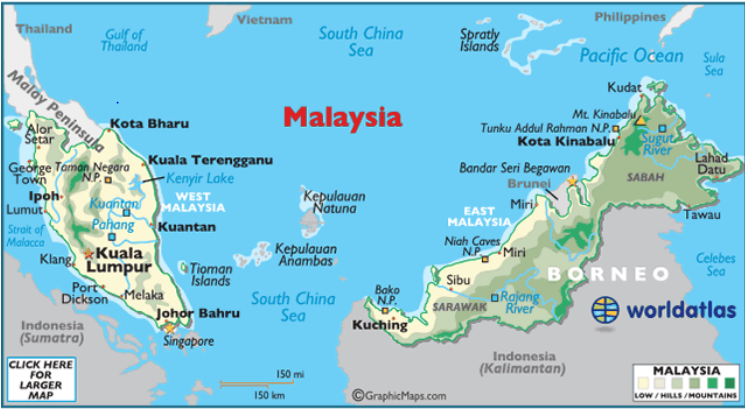
Malaysia – Kuala Lumpur
As you can see from the map, Malaysia has two provinces, Sabah abd Solewa, that are on the island of Borneo with a little enclave that is Brunei carved out of them. They joined Malaysia to get independence from Great Britain which occurred in 1963. At that time there were 14 states. In 1965 Singapore was expelled or resigned from Malaysia, depending on who tells the story.
The premier of Singapore, Yew, did not get along with the premier of Malaysia and both were stubborn men. The main argument was whether this multiracial society, Tamils from India, Chinese, both the former imported by Great Britain, and the Bumiputra (means son of the soil), the original Malay inhabitants should all be treated equally. The premier of Singapore wanted this, but in Malay the premier felt that the Bumiputra should have special privileges. This holds true today in Malaysia while there is equal treatment of the races in Singapore.
The guide we had in Malaysia, although of Indian descent, said that the Bumiputra have an edge in buying property, getting a good education and other things, but then said that they were all right with this… (Did he dare to say otherwise? I don’t know) He added that the Chinese have to work harder. Malaysia has had one party in power since its inception. Opposition is “allowed” as long as no one gets too powerful. The current opposition leader, who presumably was a threat to the power of the entrenched, is jailed on trumped up charges of being a transvestite… The parliament has something like 95 members and six are of the opposition party, so you judge. From British heritage, they drive on the left just as in Singapore.
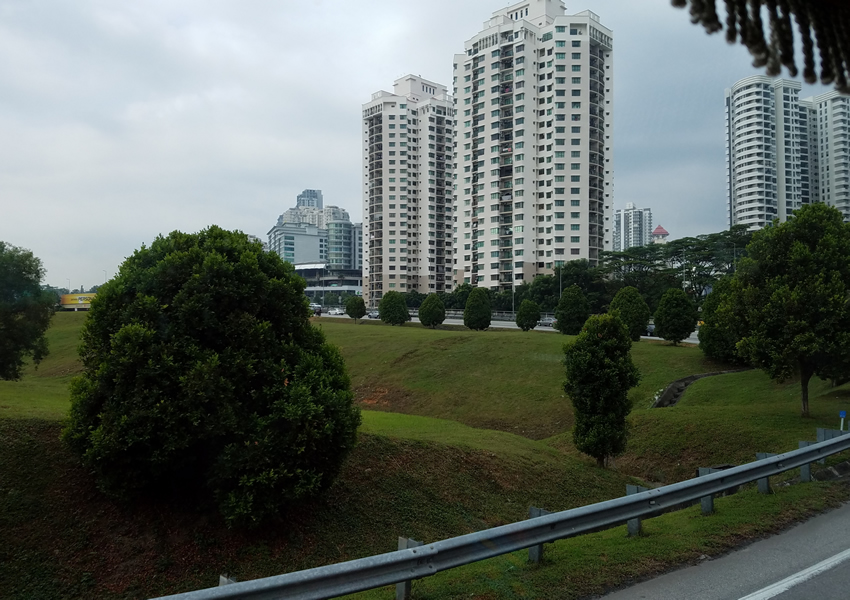
The Malaysia that I saw is not the Malaysia of my 4th grade textbook which was mostly about rice paddies and rubber trees. There was also tin mining, which either was not in the textbook, or I have forgotten. Today those mines are exhausted and the introduction of synthetic rubber has hurt that export. However, due to an abundance of hydroelectric power they export both electricity and water, the latter to Singapore.
The current economy is oil based. The guide, although he could not say how much, thought that there was an abundant supply to keep up the economy. The nearest state from which it is extracted receives a small royalty, whilst the government takes the lion's share. Much of the oil is offshore. Interesting, despite the oil industry, and hydroelectric power, some of their power plants are coal driven. Leaving Port Klang, the harbor for Kuala Lumpur, we saw coal being unloaded onto a conveyor belt for a power plant on the shore.
Elementary and secondary education is almost free from ages 7 to 17. Every year one pays a school fee that is quite low, and books are furnished. There is school for 5 and 6 year olds, but I don’t know how much that costs. There is one University in Malaysia, which is free, and the competition for entrance is stiff, with preference being given to the Bumiputra. A private university is $12,000 for 4 years, which looks inexpensive to us, but to the Malaysians it is often out of reach.
Kuala Lumpur, which like Washington, D.C, is a federal territory. It is a city that, except for the interesting architecture of the high-rise apartment and office buildings, could be found in the U.S. But, there are some slums that need cleaning up. However, like Singapore, they have no homeless because the government builds homes for these unfortunates. And we did not see any beggars, there were a few (not many) souvenir hawkers at the Petronas Towers, but not elsewhere.
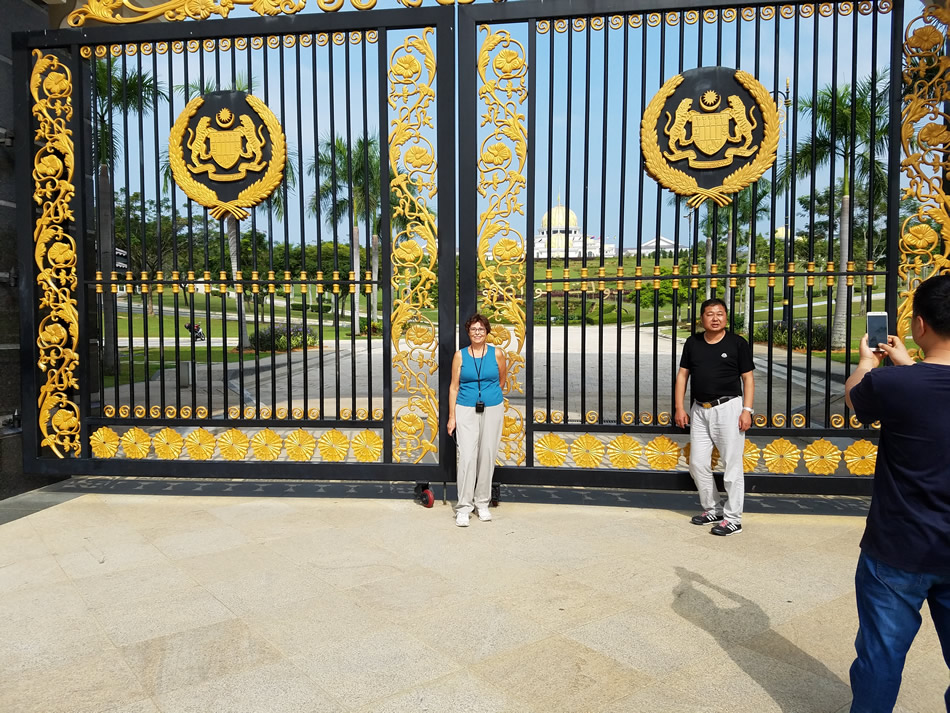
Yes, that is me in front of the palace gates.
Our first visit was to the new King’s Palace which as you would expect is very ornate. There are two guards on horseback in recesses, one on each side who are dressed in red uniforms.In the center is a guard dressed in white. The common folk are allowed in once a year. Our visit did not coincide with this day.
The position of king is fascinating. 9 of the 13 remaining states have a sultan. To keep them happy it was decided that these 9 sultans would every 5 years elect a king. Whoever is king must move to this palace, but he is not required to stay there, or even in the country. Theoretically this is a constitutional monarchy, but this king, has little if any power or influence, and has no official duties such as opening parliament When I asked a speaker what the king does I was told, “He’s king.” He has no official duties, although he might cut a ribbon every now and then.
Our next foray was to the War(s) Memorial. I add the “s” because it commemorated three wars: WWI (1914-1918), WW II (1939-1945) and their civil war (1948-1960). The memorial was designed by the same person who did the Iwo Jima Monument. If one looks closely the faces are more occidental than Asian. The flag is not an American flag, the Malay flag has 14 red and white stripes, a blue field with a yellow crescent (symbol of Islam) partially surrounding a 14 point star. The flag was designed before Singapore split with Malaysia thus the 14 point star. The memorial was surrounded by shallow polls and tile walkways.
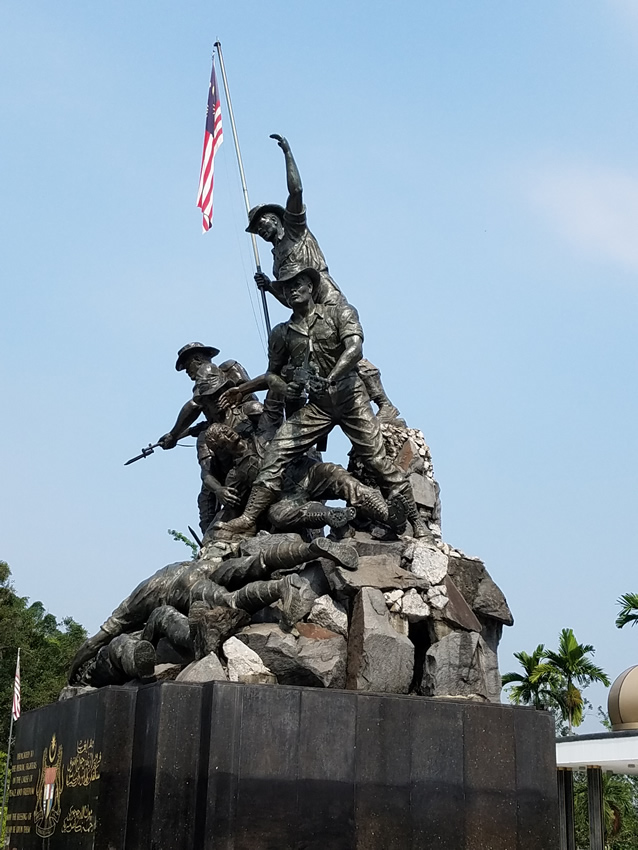
Those of us in school during the Malaysian civil war may remember learning about it as current events. It was the communist guerillas versus the republicans. In 1960 the communist leader surrendered and went into exile in Thailand.
The National Mosque of Malaysia was next on the agenda. If the men had on shorts they had to put on a burka, just like most of the woman. We women had to have our arms, legs to the ankle and head and neck except for the face covered up. I choose to wear light, long pants, a tank top with a blouse and I put on a scarf. I did not have to wear a tent (er burka) because of that. But because I had been told that I would have to wear a tent no matter what, I forgot to button up my long sleeve blouse so my neck was visible. My pink scarf did not hide it enough, but I only had a black head covering with a gold decorated bill put on me. It was kind of fun. As is normal in a mosque, the designs are beautiful, and this mosque was no exception. Yes, we removed our shoes, normal in all mosques and some Chinese temples. Saves on cleaning!
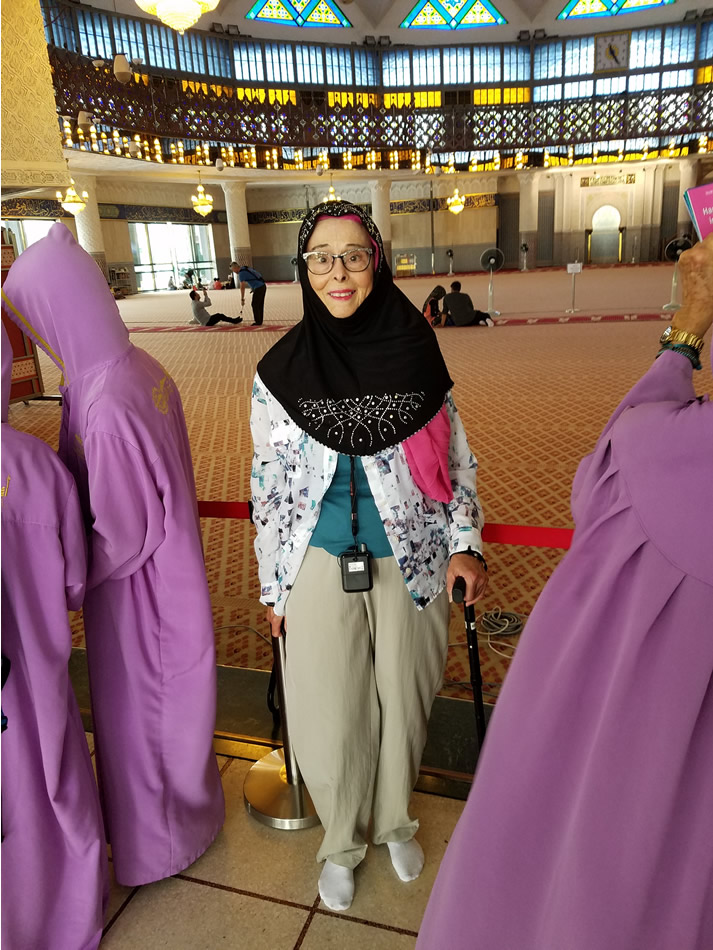
To digress a little we were told that in this multicultural society, they are all very tolerant of each other’s religions. Besides Muslims, there are Hindus, and Christians. Generally the native Malaysians are Muslims, the Chinese are Christian and the Indian Tamils Hindu, with some exceptions. Our guide was of Indian descent, but was Christian. In respect to all the religions, all of the religions holidays are national holidays, with time off for everyone, and the city is decorated accordingly. The guide said that if we came there at Christmas time we would find it decorated for Christmas complete with Santa Claus, but minus snow. Except for the cotton glued on the Christmas Trees.
A trip to the top of the Menara Tower was fun. It is 421 meters tall, but we did not get to the very top. Still there was a wonderful view from the observation area with the ability to see in all directions. Like the last two cities we have visited, the city goes on forever in all directions! The photo below is just one of the views available from the 360 degree viewing area.
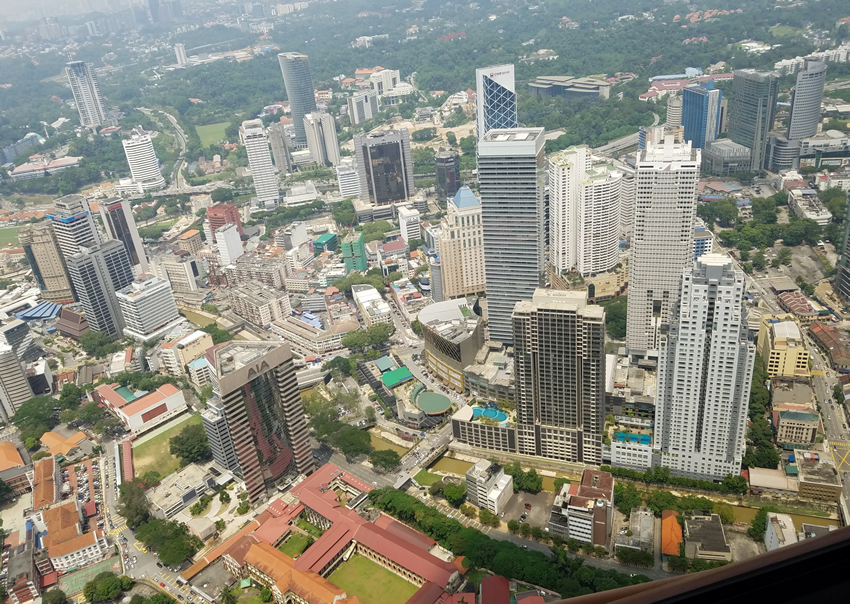
We had a delightful buffet lunch at the Intercontinental Hotel – need I say more! There was a backdrop of a waterfall behind two side of the lunchroom. Aa great ambience.
A street view and photo snapping of the Petronas Towers followed lunch. Kind of fun, they are tall and have a bridge between them. Oil, of course is their reason for existing. they are all offices and there is no observation tower.
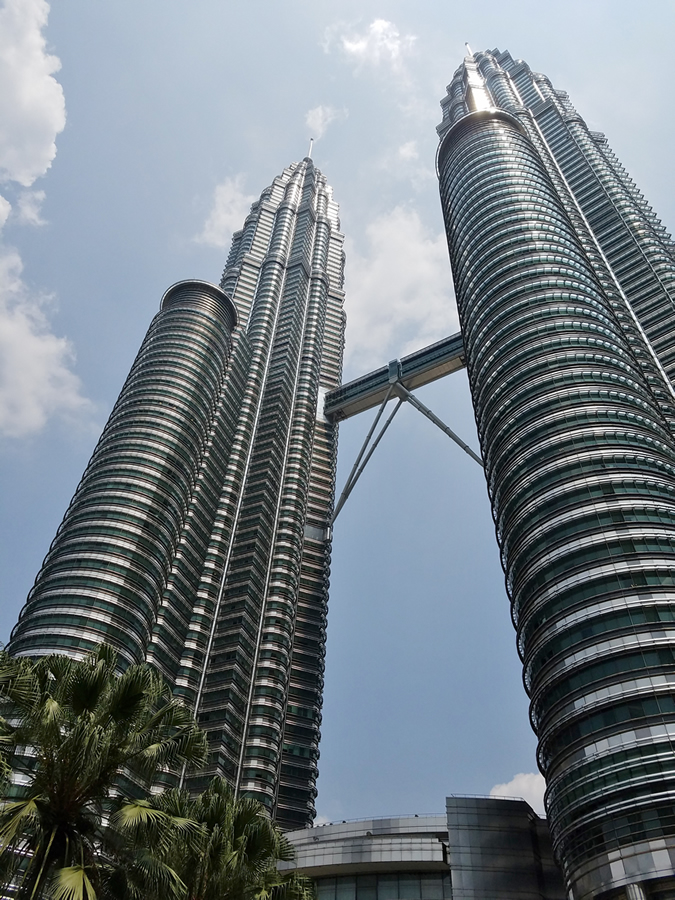
The economy is booming, and has not faltered with the decrease in the price of oil. Women and men have equal pay. Malaysia also manufactures electrical goods and their factories run 24/7. Hence the need for women workers. The guide never talked about a glass ceiling…
The last stop was the Budhist Thean Hoo Temple. We were all sort of blasé, having seen a number of temples, but this one was exceptional. It features three goddesses: the Heavenly Mother, in the center of the temple, the Goddess of the Waterfront on her right, and the Goddess of Mercy on her left. As is usual in these temples, there were worshippers there. I always am reluctant to enter a temple when there are people there praying, but in these temples that we have visited in Asia including SE Asia, apparently as long as we maintain decorum there is no problem. It is not as if we are interrupting a service. Except for the mosques who have services on Friday, one can visit at all times.

The above photo is just an example of the temple decorations.
I really had never thought too much about Malaysia, and if I considered it all, I passed it off as a third world country. The last 40 years have been a turning point for both Malaysia and Singapore. Kuala Lumpur except for the temples and mosques, and many high-rise apartment buildings could be an U.S. city. Malaysia, at least in Kuala Lumpur, is a going concern, the people there work hard, are intelligent and want what we all want: a good life and security. Like Korea where you can’t tell where the port city ends and Inchon begins, there is no rural area between Port Klang and Kuala Lumpur.
It is impossible not to look back on the SE Asia countries of China, Vietnam, Singapore and Malaysia and not make some comparisons. China and Vietnam are communist, not as bad as a few decades ago, but still a more contrived environment. Singapore and Malaysia are both benevolent dictatorships, but entrepreneurial. I felt freer in these last two cites, and they were both far cleaner. I think that the inhabitants have more self-respect. The citizens of all the countries were very friendly, but I far preferred Singapore and Malaysia.
Now on to Sri Lanka about 1400 mile from Port Klang. Our route took us through the famous Straits of Malacca, an 18 mile wide potential bottle neck in sea lanes, with traffic to match. 23 hours after leaving the Straits we were in the Andaman Sea which becomes the Bay of Bengal/Indian Ocean after rounding the Indonesian island of Sumatra.
The Straits of Malacca is one of the busiest sea lanes in the world - just now I counted 4 freighters going the other way outside just my view on the port side.
The weather for this crossing was wonderful. Temperature in the 80s outside and sea temperature 88. Calm winds, blue sky. We have to enjoy it and get some energy back because Sri Lanka will be just as hot as all the ports since Hong Kong.
After two nights of gaining an hour each night the evening between Malaysia and Sri Lanka we gained half an hour. Sri Lanka, like some other areas such as Adelaide, Australia and Newfoundland, Canada is on the half hour.